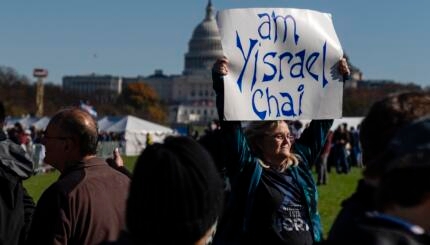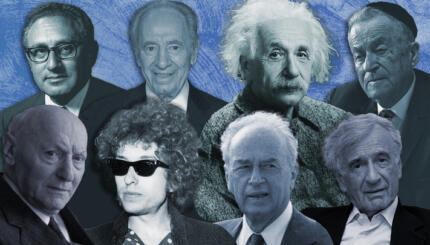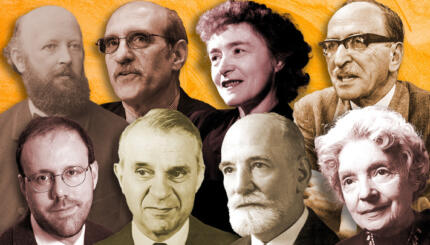The category of secular Jewish music is as elusive as it is important. It may be broadly defined as any music used primarily by Jews in non-liturgical contexts. Our knowledge of secular Jewish music through the generations is necessarily limited, since it has been transmitted primarily via oral tradition, much of which we presume has been lost. It includes such phenomena as the folk song, the nigun (wordless tune), theater music, and epic recitation.
But to say that the category consists of music “used” by Jews fails to account for musical phenomena like Fiddler on the Roof: Though the show’s music was written by a Jewish composer and its story was based on literature of a Jewish author, it was intended primarily for non-Jewish Broadway audiences. Nevertheless, it has for decades served as a Jewish cultural icon, and it continues to influence the self-image of the American Jewish community.
The question of the influence of non-Jewish musical traditions is essential in the discussion of all Jewish musical practice, but especially so in secular genres, where musicians were perhaps more ready to adopt non-Jewish elements.
The friendly ties between the Sephardic community of Spain and its non-Jewish neighbors before the Inquisition resulted in considerable interaction and hybrid innovations in philosophy and literature (Maimonides, for example)–and in music. The romansas–songs of love and heroism along the lines of epic poetic recitation, which even today form part of the musical tradition–derive from this cultural intersection. Through contact in later generations with the music of host countries such as Turkey and Bulgaria, the Sephardic community has continued to develop its tradition of folk songs, drawing on local modal and melodic patterns.

Help us keep Jewish knowledge accessible to millions of people around the world.
Your donation to My Jewish Learning fuels endless journeys of Jewish discovery. With your help, My Jewish Learning can continue to provide nonstop opportunities for learning, connection and growth.
By contrast, our knowledge of the secular musical traditions of the Ashkenazic community is sparse before the 19th century. We can assume that folk melodies existed, as they do in every society, but they were not written down and not deemed important enough to be maintained with any fixity. The most extensive body of secular Ashkenazic folk music from before the 19th century are the Hasidic niggunim. It was perhaps because of the emphasis on the personal, emotional quest for a relationship with God that Hasidim created this body of textless song.
The contrast between the Sephardic and Ashkenazic communities in this regard is striking: While the Sephardim maintained a secular musical tradition based in large part on the music of their non-Jewish neighbors, the Ashkenazim seem not to have applied great effort to the creation of secular music until the emancipation of Jews in Europe and the birth of the Haskalah (Jewish Enlightenment) movement in the 19th century. Until that point non-Jewish governments enforced a strict separation from the Jews who resided in their lands; Jews lived in ghettos and had little interaction with non-Jewish neighbors.
With the emancipation came a desire on the part of “enlightened” Jewish intellectuals to educate the Jewish community in aspects of non-Jewish culture, including music. As Reform temples incorporated organs and other instruments into their liturgical practice, Jews simultaneously began to learn about non-Jewish theater and instrumental music.
After a time, though, the Jewish intelligentsia came to see Jewish musical culture as distinct from that of the non-Jews; intellectuals such as Mendele Mokher Seforim cultivated a Yiddish literature, and Abraham Goldfaden composed operettas using themes of Jewish history and Zionism to appeal to the political sensibilities of his co-religionists. Though Goldfaden’s music is based on the tonal organization of western European music, he sprinkled his songs with pseudo-eastern melodies to give them a more culturally Jewish sound.
The revolution in Yiddish theater sparked by Goldfaden and his followers interacted with the Yiddish folk tradition in Europe–the famous folk lullaby “Raisins and Almonds” is from a Goldfaden operetta–and the instrumental klezmer tradition. When Yiddish music was imported to America its texts and contexts were gradually translated for an increasingly English-speaking audience. While the Yiddish music tradition may still be heard in the recent klezmer revival and in occasional musical theater performances at the Folksbiene (a Yiddish theater in New York), the Jewish folk tradition veered in the direction of general American folk music, as in the works of Debbie Friedman and Safam.
Of particular importance during the 20th century was the use of music for political ends. During the Holocaust, music instilled a fighting spirit among Jews in ghettos and concentration camps and helped document the horrors there. In Palestine and the early State of Israel, the conscious creation of a body of folk music was deeply connected with Zionism and the quest for self-determination. Today Israeli popular music expresses Jewish themes in the musical contexts of European popular song styles.


